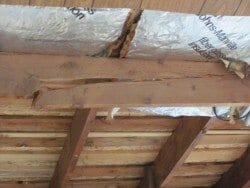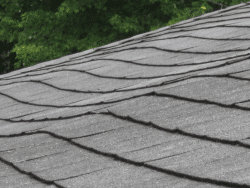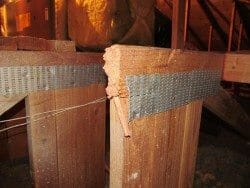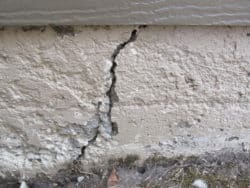When Are Permits Required To Repair a Roof or Reroof a House?
Home » Codes & Permits »
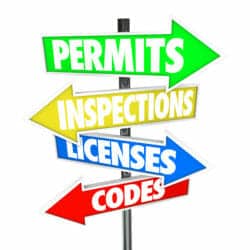
Are permits required to repair a roof or reroof a house?
Permits may be required to repair a roof, depending on the size of the area being repaired and the type of repairs. They may also be required when reroofing, depending on the local building jurisdiction.
Homeowners and buyers should avoid jumping conclusions about whether a permit is required or not, for there may be consequences.
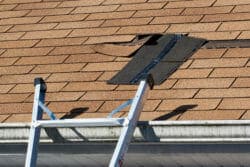
Building jurisdictions may base permit requirements on size of area being repaired
There are many building jurisdictions that exempt permit requirements for repairs, if the area is under a specific size, i.e. under 200 square feet or less than 1/10 of the total square foot area of the entire roof. Note the requirements may vary from one locality to another.
If repairing a small area of a roof that is leaking, or one that has a few broken tiles or missing shingles, then the building department usually views this work as merely maintenance.
Is there structural damage?
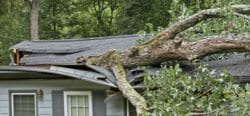
If a roof has structural damage from a wind storm, exceedingly large snow load, hurricane or a tree falls on the roof, then permits are usually required to do the roof repairs.
Structural damage is generally considered more serious and may need a set of plans and an engineering review by the building department.
Leaking over the long-term: damaged roof sheeting, rafters or trusses.
Plywood or OSB roof sheeting can be badly damaged when exposed to moisture from slow and long-term leaks. Rafters and roof trusses may likewise suffer damage from these types of leaks. Wood rot and deterioration weakens framing members over time and some of the framing members may need to be replaced. Depending on the severity of damage, a permit may be required to repair and correct these problems.
When not repaired for long periods of time, wood rot and mold and mildew may develop. (Read about- mold, causing structural damage referred to as “Building Cancer”)

Roofs in high fire risk areas
Homes built in areas that are considered high fire risk areas generally must meet higher standards and code requirements. Wildfire areas are invariably associated with strong winds and convection columns when fires occur and generally roofs on these homes require higher fire ratings and special installation; therefore, building departments are more likely to require permits for major repairs and reroofing projects in these areas.
Homeowners may be required to upgrade the fire rating of their roofs as well as change the types of roof vents and other penetrations to resist heat and embers.
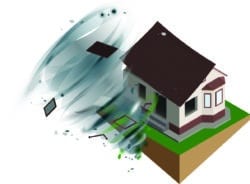
High wind areas
Roofs in areas that are subject to high winds, tornadoes and hurricanes will often experience gusting and turbulent winds that change directions, often carrying flying debris with them. Roofing codes in these areas are more stringent and both repairs and reroofing are more likely to require permits.
Tip: If your roof has suffered damage due to a tornado, hurricane or other wind events, take a few minutes and go into your attic and check for damage. Look for cracked or damaged rafters or trusses, ones that are leaning or sagging and for evidence of water damage.
Normally you can do temporary or emergency repairs under certain conditions
Most building jurisdictions allow for repairs to be done temporally if it is necessary to stop further damage to a home and until a permit and proper repairs can be made; i.e. a storm has blown off an area of the roofing and is damaging the interior of the house.
Reroofing
Reroofing a home may require permits in many building jurisdictions due to a number of concerns. First, there is the concern about the weight of the new roof; is it heavier than what the roofs’ framing is designed for? If the old roof was wood shingles, which are very light in weight, is replaced with a concrete tile roof, which is very heavy, then there may be a structural failure or even a collapse.
Secondly, is the new roof being placed on top of the existing roof. This is also weight concern, as well as a concern that the new roof is not compatible with the old roof.
Code changes
There has been code changes for homes in high fire risk areas and ones that are subject to strong wind conditions. These changes relate to the type of materials that can be used and how the roofing materials are to be installed. Building departments in these areas usually requiring permits when reroofing or if major repairs are being made.

Insurance claims
Although Homeowners Insurance pays many types of claims, depending on your policy, when there is roof damage; they may fail to pay claims after a roof has been repaired or reroofed if a permit was required but none was obtained when the work was done.
An example might be that a home in a high fire risk or wind area was reroofed with materials that were not approved for the area, and later there was a fire or wind storm that damaged the roof. The insurance company might claim that if you had gotten a permit, that proper materials and installation would have been done, and there would not have been a loss. That you were responsible for the loss or at least contributed to it and therefore the claim is denied. Insurance underwriting policies vary from insurance company to insurance company; therefore, it is wise to understand your policy and check with your insurance company regarding permits, repairs and reroofing issues and requirements.
Don’t forget the Homeowners Association, if there is one
Homeowner associations may have requirements regarding repairs and reroofing. They may not allow or want repairs that fail to match the existing roof color or material types; they want the repairs to blend in, not stand out.
When reroofing a homeowner may be required to go through the homeowners architectural committee or board to satisfy the association requirements.

Permit requirements vary from locality to locality, depending on what is being done. In some building jurisdictions you may be required to obtain a permit to repair or reroof a house and in another building jurisdictions no permit may be required.
Small repairs, especially non-structural one, may fall in the category of maintenance.
Building codes have changed, especially in areas subject to high fire or wind risk; building departments in these areas are prone to require permits for a number of repairs and for reroofing.
Checking with the local building department is recommended. Calling or visiting your local building department will generally answer the question of when a permit is required. A number of building departments may even have helpful information available on line.

